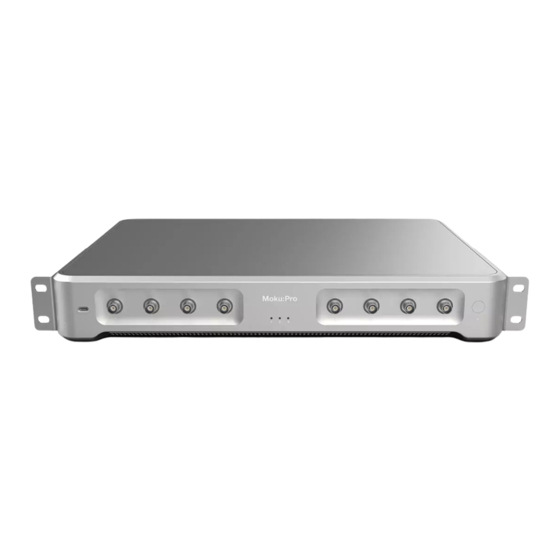
Liquid Instruments Moku:Pro User Manual
Pid controller
Hide thumbs
Also See for Moku:Pro:
- Quick start manual (2 pages) ,
- User manual (25 pages) ,
- Quick start manual (2 pages)
Table of Contents
Advertisement
Quick Links
PID Controller
Moku:Pro User Manual
Moku:Pro's PID (Proportional-Integrator-Differentiator) Controller features four fully real-time
configurable PID controllers with a closed-loop bandwidth >100 kHz. This enables them to be used
in applications requiring both low and high feedback bandwidths such as temperature and laser
frequency stabilization. The PID Controller can also be used as a lead-lag compensator by
saturating the integral and differential controllers with independent gain settings.
www.liquidinstruments.com
2021 Liquid Instruments. All rights reserved.
Advertisement
Table of Contents

Summary of Contents for Liquid Instruments Moku:Pro
- Page 1 PID Controller Moku:Pro User Manual Moku:Pro’s PID (Proportional-Integrator-Differentiator) Controller features four fully real-time configurable PID controllers with a closed-loop bandwidth >100 kHz. This enables them to be used in applications requiring both low and high feedback bandwidths such as temperature and laser frequency stabilization.
-
Page 2: Table Of Contents
PID Response Plot PID Paths PID Path Preview List of Configurable Parameters in Basic Mode Controller (Advanced Mode) Quick PID Control Probe Points ............................17 Oscilloscope Data Logger | Moku:Pro’s PID Controller User Manual © 2021 Liquid Instruments. All rights reserved. - Page 3 Ensure Moku:Pro is fully updated. For the latest information: www.liquidinstruments.com | Moku:Pro’s PID Controller User Manual © 2021 Liquid Instruments. All rights reserved.
-
Page 4: User Interface
User Interface Moku:Pro is equipped with four inputs, four outputs, and four PID controllers. Two control matrices are used to create two multiple-input and multiple-output (MIMO) in groups for PID 1 &2, and PID 3&4. You can tap the icons to switch between MIMO group 1 and 2. MIMO group 1 (inputs 1 and 2, PID 1 and 2, Output 1 and 2) is used throughout this manual. - Page 5 Input configuration for Channel 2 Control matrix Configuration for PID Controller 1 Configuration for PID Controller 2 Output switch for Channel 1 Output switch for Channel 2 Enable the oscilloscope | Moku:Pro’s PID Controller User Manual © 2021 Liquid Instruments. All rights reserved.
-
Page 6: Main Menu
Main Menu The main menu can be accessed by pressing the icon, allowing you to: | Moku:Pro’s PID Controller User Manual © 2021 Liquid Instruments. All rights reserved. -
Page 7: Preferences
Moku:Pro automatically saves instrument settings when exiting the app, and restores them again at launch. When disabled, all settings will be reset to defaults on launch. Moku:Pro can remember the last used instrument and automatically reconnect to it at launch. When disabled, you will need to manually connect every time. -
Page 8: Input Configuration
Details about the probe points can be found in the Probe Points section. | Moku:Pro’s PID Controller User Manual © 2021 Liquid Instruments. All rights reserved. -
Page 9: Control Matrix
10, or 1 increment when the absolute value is between 10 and 20. Tap the element to adjust the value. | Moku:Pro’s PID Controller User Manual © 2021 Liquid Instruments. All rights reserved. -
Page 10: Pid Controller
Probe Points section for details. Moku:Pro output Tap to disable or enable DAC output with 0 dB or 14 dB gain. switch Input / Output Switches Closed/Enable Open/disable | Moku:Pro’s PID Controller User Manual © 2021 Liquid Instruments. All rights reserved. -
Page 11: Controller (Basic Mode)
PID control switches Turn on/off individual controller. Advanced mode Tap to switch to the advanced mode. Overall gain slider Swipe to adjust overall gain of the controller. | Moku:Pro’s PID Controller User Manual © 2021 Liquid Instruments. All rights reserved. -
Page 12: Pid Response Plot
○ 1 and ○ 2 ) represent the cursors for each controller. ○ bold red dashed line 3 ) represents the cursor for actively selected parameter. | Moku:Pro’s PID Controller User Manual © 2021 Liquid Instruments. All rights reserved. -
Page 13: Pid Paths
DS Differentiator saturation level Each button has three states: off, preview, and on. Tap the buttons to circle these states. Long press the buttons to go reverse order. | Moku:Pro’s PID Controller User Manual © 2021 Liquid Instruments. All rights reserved. -
Page 14: Pid Path Preview
Integrator saturation level ± 60 dB or limited by the crossover frequency/proportional gain Differentiator saturation level ± 60 dB or limited by the crossover frequency/proportional gain | Moku:Pro’s PID Controller User Manual © 2021 Liquid Instruments. All rights reserved. -
Page 15: Controller (Advanced Mode)
This panel allows user quickly to view, enable, disable, and adjust the PID controller without open the controller interface. It is only available in basic PID mode. | Moku:Pro’s PID Controller User Manual © 2021 Liquid Instruments. All rights reserved. - Page 16 Tap the faded icon (i.e. ) to enable the path. Tap the active controller path icon (i.e. ) to enter the value. Hold and slide to adjust the value. | Moku:Pro’s PID Controller User Manual © 2021 Liquid Instruments. All rights reserved.
-
Page 17: Probe Points
Probe Points Moku:Pro’s PID controller has an integrated oscilloscope and data logger that can be used to probe the signal at the input, pre-PID, and output stages. The probe points can be added by tapping the icon. Oscilloscope ID Parameter... -
Page 18: Data Logger
Tap to place the probe at output. Oscilloscope/data Toggle between built-in oscilloscope or data logger. logger toggle Data Logger Refer to the Moku:Pro’s Data Logger manual for the details. | Moku:Pro’s PID Controller User Manual © 2021 Liquid Instruments. All rights reserved. - Page 19 Ensure Moku:Pro is fully updated. For the latest information: www.liquidinstruments.com | Moku:Pro’s PID Controller User Manual © 2021 Liquid Instruments. All rights reserved.



Need help?
Do you have a question about the Moku:Pro and is the answer not in the manual?
Questions and answers